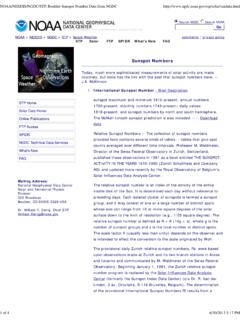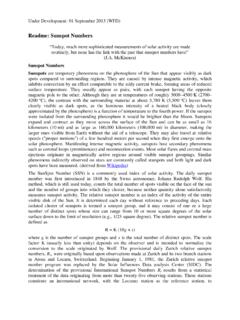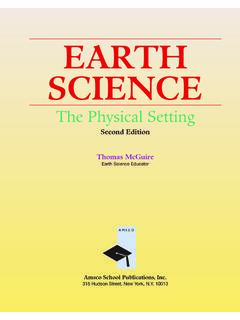Transcription of NOAA Technical Memorandum NESDIS NGDC-
1 Noaa /NATIONAL OCEANIC ANDATMOSPHERIC ADMINISTRATIONN ational Environmental Satellite,Data, and Information ServiceNOAA Technical Memorandum NESDIS NGDC- 24 ETOPO1 1 ARC-MINUTE GLOBAL RELIEF MODEL:PROCEDURES, DATA SOURCES AND ANALYSIS C. Eakins National Geophysical Data CenterMarine Geology and Geophysics DivisionBoulder, ColoradoMarch 2009 UNITED STATESDEPARTMENT OF COMMERCEGary LockeSecretaryNATIONAL OCEANIC ANDATMOSPHERIC ADMINISTRATIONDr. Jane LubchencoUnder Secretary for Oceansand Atmosphere/AdministratorNational Environmental Satellite, Data, and Information ServiceMary E. KiczaAssistant AdministratorNOAA Technical Memorandum NESDIS NGDC- 24 ETOPO1 1 ARC-MINUTE GLOBAL RELIEF MODEL:PROCEDURES, DATA SOURCES AND ANALYSIS Christopher Amante1 Barry W.
2 Eakins2 1 NOAA Ernest F. Hollings Undergraduate Scholar, Boulder, Colorado 2 Cooperative Institute for Research in Environmental Sciences, University of Colorado, Boulder National Geophysical Data CenterMarine Geology and Geophysics Division Boulder, ColoradoMarch 2009 Amante and Eakins, 2009iiNOTICEM ention of a commercial company or product does not constitute an endorsement by the NOAA National Environmental Satellite, Data, and Information Service. Use of information from this publication concerning proprietary products or the test of such products for publicityor advertising purposes is not authorized. Corresponding project contact:Barry E. EakinsNOAA, National Geophysical Data CenterMarine Geology and Geophysics Division325 Broadway, E/GC 3 Boulder, Colorado 80305 Phone: 303-497-6505 Fax: 303-497-6513E-mail: available from the National Technical Information Service (NTIS)( )ETOPO1 1 Ar c-Mi n uT E Gl O b A l rE l i E f MO d E liiiCo n t e n t s1.
3 Introduction ..12. Study Area ..23. Methodology .. Data Sources and Processing .. Shoreline .. Bathymetry .. Topography .. Integrated Bathymetry Topography .. Bedrock .. Establishing Common Datums .. Vertical datum transformations .. Horizontal datum transformations .. Digital Elevation Model Development .. Verifying consistency between data sets .. Gridding of coastal bathymetry .. Gridding the data with Registration of grids .. Quality Assessment of the DEM .. Horizontal and vertical accuracy ..174. Summary and Conclusions ..175. Acknowledgments ..186. References ..187. Data Processing Software ..19Li s t o f fi g u r e sFigure 1. Color, shaded-relief image of the ETOPO1 Ice Surface Global Relief Model.
4 1 Figure 2. Color, shaded-relief image of the ETOPO1 Bedrock Global Relief Model ..2 Figure 3. Source and coverage of data sets used to compile the ETOPO1 Ice Surface Global Relief Model ..3 Figure 4. Source and coverage of data sets used to compile the ETOPO1 Bedrock Global Relief Model ..3 Figure 5. Color image of Caspian Sea depth contours and bathymetric grid ..6 Figure 6. Color image of Mediterranean Sea morpho-bathymetric map ..6 Figure 7. A row of bad data present in the SRTM30 data set ..7 Figure 8. Coverage of GLOBE topography that was used in building 9. Anomalous depth values in the Measured and Estimated Seafloor Topography grid in shallow coastal waters north of Vancouver Island ..10 Figure 10.
5 Color image of the IBCAO grid of the Arctic ..11 Figure 11. Areas of the coast covered by NGDC s Coastal Relief Model ..12 Figure 12. Color image of the Estimated Seafloor Topography grid along Iceland s northwest coast ..15 Figure 13. Color image of Iceland s northwest coast in ETOPO1 ..15 Figure 14. Differences between grid-registration and cell-registration ..17Li s t o f ta bL e sTable 1. Specifications for ETOPO1 ..2 Table 2. Shoreline data sets used in evaluating ETOPO1 source data 3. Bathymetric data sets used in compiling ETOPO1 ..5 Table 4. topographic data sets used in compiling ETOPO1 ..7 Table 5. Integrated bathymetric topographic data sets used in compiling ETOPO1 ..9 Table 6. Bedrock elevation data sets used in compiling the ETOPO1 Bedrock Global Relief Model.
6 13 Table 7. Data hierarchy used to assign gridding weight in MB-System ..16[Page left intentionally blank]ETOPO1 1 Arc-Minute Global Relief ModelProcedures, Data Sources and Analysis1. in t r o d uC t i o nIn August 2008, the National Geophysical Data Center (NGDC), an office of the National Oceanic and Atmospheric Administration (NOAA) developed the ETOPO1 1 Arc-Minute Global Relief Model as an improvement to the ETOPO2v2 Global Relief Model. ETOPO1 is available in Ice Surface (top of Antarctic and Greenland ice sheets; Fig. 1) and Bedrock (base of the ice sheets; Fig. 2) versions. Both versions of ETOPO1 were generated from diverse global and regional digital data sets (coverage shown in Figs.)
7 3 and 4), which were shifted to common horizontal and vertical datums, and then evaluated and edited as needed. This report provides a summary of the data sources and methodology used in developing ETOPO1. Figure 1. Color, shaded-relief image of the ETOPO1 Ice Surface Global Relief and Eakins, 20092 Figure 2. Color, shaded-relief image of the ETOPO1 Bedrock Global Relief Model. Illumination from the st u d y ar e aETOPO1 provides complete global topographic and bathymetric coverage between -90 to +90 in latitude and -180 to +180 in longitude. 3. Me t h o d oL o g yETOPO1 was developed to improve the resolution and accuracy of the ETOPO2v2 2 arc-minute Global Relief Model, and was designed to support tsunami forecasting, modeling and warning, as well as ocean circulation modeling and Earth visualization.
8 The best available regional and global digital data sets were obtained by NGDC and shifted to common horizontal and vertical datums: World Geodetic System 1984 (WGS 84) and sea level. Data processing, evaluation, assembly and assessment of ETOPO1 are described in the following 1: Specifications for Surface, BedrockCoverage Area Global: -180 to 180 ; -90 to 90 Coordinate SystemGeographic decimal degreesHorizontal DatumWorld Geodetic System of 1984 (WGS 84)Vertical DatumSea LevelVertical UnitsMetersCell Size1 arc-minuteGrid FormatMultiple: netCDF, g98, binary float, tiff, xyzETOPO1 1 Ar c-Mi n uT E Gl O b A l rE l i E f MO d E Data Sources and ProcessingShoreline, bathymetric, topographic , integrated bathymetric topographic , and bedrock digital data sets (data footprints shown in Figs.)
9 3 and 4) were obtained from several government agencies, international agencies and academic institutions. Safe Software s ( ) Feature Manipulation Engine (FME) data translation tool package was used to shift data sets to WGS 84 horizontal datum and sea level vertical datum, and to convert them into ESRI ( ) ArcGIS shape files and rasters. The shape files and rasters were then displayed with ArcGIS to assess data quality and manually edit data sets. Wessel and Smith s [1991, 1995] Generic Mapping Tools (GMT) version ( ) and Caress and Chayes [1995] MB-System version ( ) were used to grid the data and build the global relief model. Figure 3. Source and coverage of data sets used to compile the ETOPO1 Ice Surface Global Relief 4.
10 Source and coverage of data sets used to compile the ETOPO1 Bedrock Global Relief and Eakins, ShorelineCoastline data sets were obtained from NGDC and the Antarctica Digital Database (Table 2). Both coastline data sets were used in evaluating individual source data sets and ETOPO1. They were also used to clip some data sets to the coastline to eliminate anomalous 2: Shoreline data sets used in evaluating ETOPO1 source data TypeSpatial ResolutionOriginal Horizontal Datum/Coordinate SystemOriginal Vertical DatumURLNGDCGSHHS2003 Hierarchically arranged closed polygonsApproximately 100 mWGS 84 Coastline1993 to 2006 Derived from mapsRanges from 5 m to 5 kmWGS 84 :8080/add/1) GSHHSNGDC disseminates the GSHHS (Global Self-consistent, Hierarchical, High-resolution Shoreline) in ArcGIS format.





